Baiting Groundhogs: Strategies for Effective Control
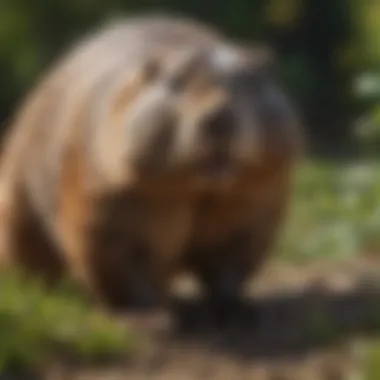
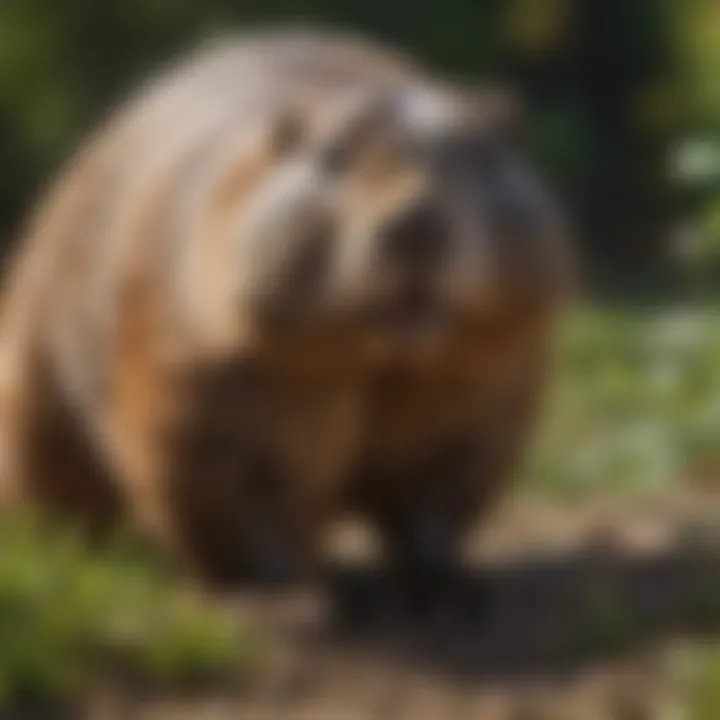
Intro
Groundhogs, often referred to as woodchucks, present a unique challenge for many homeowners and gardeners. Known for their burrowing habits and voracious appetite, these creatures can wreak havoc on gardens and landscaping, leading to frustration and a search for effective management strategies. In this article, we will explore various baiting techniques, the behavior of groundhogs, and how to implement successful pest management strategies while being ethical.
Understanding the ways to attract and manage groundhogs through appropriate baiting methods is essential for anyone dealing with these pests. By recognizing their diet and habits, one can select suitable baits that will entice these rodents. Additionally, we will delve into strategic bait placement and discuss ethical considerations that every homeowner should keep in mind when managing groundhog populations.
By the end of this article, readers will have a well-rounded view of groundhog behavior, the types of bait that yield the best results, and how to foster a balance between effective pest management and environmental responsibility.
Understanding Pests
Groundhogs fall into the category of pests for gardeners and homeowners due to their potential for damage. Understanding what defines a pest and recognizing its significance helps in developing effective management strategies.
Definition of Pests
Pests are organisms that cause harm to human interests, including health, property, and food production. Groundhogs are classified as pests because they can destroy crops and gardens, dig extensive burrows, and often contribute to soil erosion.
Importance of Pest Identification
Identifying pests correctly is crucial. Misidentification can lead to ineffective pest control methods that fail to address the real problem. Knowing that groundhogs are primarily herbivores, consuming a range of plants including clover, dandelions, and vegetables, aids in selecting appropriate bait. Effective management starts with understanding not only the type of pest but also its behavior and feeding patterns.
Prevention Techniques
Preventative measures can significantly reduce the presence of groundhogs. Fostering an environment that deters these animals is often more effective than merely controlling them once they’ve invaded.
Home and Garden Preventative Measures
- Fencing: Installing a sturdy fence around gardens can be effective. Fences should be at least three feet high and buried a foot deep to deter burrowing.
- Plant Selection: Consider planting flowers and shrubs that are unappealing to groundhogs, such as mint or lavender.
- Habitat Modification: Reducing tall grass and dense shrubbery near the home makes the area less appealing as a habitat.
Seasonal Prevention Tips
- Spring: Monitor plant growth and remove clover and dandelions, which are attractive to groundhogs.
- Summer: Harvest fruits and vegetables promptly to avoid attracting groundhogs.
- Fall: Close gaps and burrows to minimize winter nesting.
- Winter: Ensure debris and loose materials are cleared from the yard to lessen hiding spots.
Eco-Friendly Pest Control Solutions
Sustainable practices in pest management foster a balance between human needs and wildlife conservation.
Overview of Sustainable Practices
Using eco-friendly methods to deter groundhogs involves minimal disruption to their habitats. This could include strategies like introducing native predatory animals in a safe environment or using plants that groundhogs dislike.
Natural Remedies and Their Effectiveness
- Capsaicin: Spraying plants with hot pepper can deter groundhogs.
- Garlic and Soap Mixture: A solution made from garlic, water, and soap can be an effective repellent.
- Predator Urine: Utilizing the scent of predators like foxes may discourage groundhogs from entering areas.
Employing an array of sustainable practices not only protects gardens but also promotes harmony between humans and wildlife.
Intro to Groundhogs
Understanding groundhogs is crucial for anyone dealing with gardening or property management. These animals, often referred to as woodchucks, can significantly impact landscapes, gardens, and even agricultural operations. They are known for their burrowing behavior and can pose challenges when they invade areas for food.
The insights gathered in this section will delve into both the behavior and habitat of groundhogs. Recognizing their habits and territorial range is not merely an academic pursuit. Instead, this knowledge serves a practical purpose, especially for homeowners who wish to mitigate potential damages caused by these persistent animals.
By comprehensively discussing groundhog behavior and habitat, readers can gain valuable perspective on the best practices for managing their presence. A clear understanding of these elements lays the groundwork for effective baiting strategies, enhancing the overall quality of pest management efforts.
Overview of Groundhog Behavior
Groundhog behavior is characterized by specific patterns that emphasize their feeding habits and seasonal activities. Groundhogs are primarily herbivorous and feast on a variety of plants, which makes them particularly attracted to gardens. They tend to feed during early morning and late afternoon, demonstrating a level of caution.
Their social structure is generally solitary, except during mating seasons. Mating occurs in the spring, and mothers raise their young in burrows. This social behavior influences their population dynamics and plays a role in why certain baits may attract them more effectively at different times of the year.
Groundhog Habitats and Range
Groundhogs are adaptable creatures that prefer habitats with ample vegetation and soft soil for digging. They are often found in fields, forests, and residential areas. Their range typically spans throughout the United States and parts of Canada.

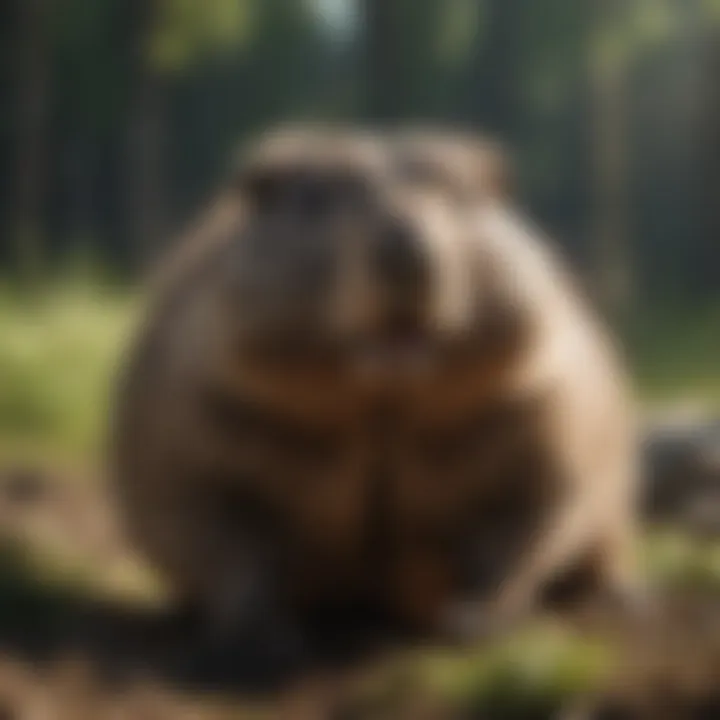
These animals dig extensive burrow systems, which serve as homes and food storage. Each burrow can be more than a meter deep and have multiple entrances, making it essential to identify active burrows when planning bait placements. Furthermore, knowing where they thrive can assist in preventing their encroachment. Identifying these habitats is key in formulating effective management strategies.
Understanding Groundhog Diet
Understanding the diet of groundhogs is crucial for anyone looking to manage their presence effectively. Groundhogs, or woodchucks, are herbivorous animals. This means their diet primarily consists of plant matter. By grasping what these animals prefer to eat, homeowners and gardeners can select baits that are more likely to attract them. A knowledgeable approach to bait selection can enhance success in managing these creatures, as well as mitigate any potential issues they may cause in gardens or yards.
Groundhogs play an active role in the ecosystem. Their foraging behavior can impact local vegetation. Thus, understanding their dietary habits also allows for more comprehensive pest management practices, supporting healthier environments.
Preferred Food Sources
Groundhogs have a varied diet, consuming many types of vegetation. Their primary food sources include:
- Grasses and Legumes: Groundhogs tend to graze on various grasses, especially during the warmer months.
- Fruits: They are particularly attracted to fruits like apples, berries, and melons.
- Vegetables: In gardens, they often munch on beans, carrots, and leafy greens.
- Herbs: Certain herbs can also attract groundhogs.
Groundhogs prefer tender, young plants over older, tougher ones. This is significant when selecting bait. For effective baiting, homeowners should consider what plants are currently in season and what is most appealing to groundhogs during that time. Groundhogs will often forage for food close to their burrows, which means it is beneficial to set bait nearby.
Seasonal Variations in Diet
Groundhog dietary preferences can change with the seasons. In spring, they emerge from hibernation and look for tender greens and shoots. As summer progresses, fruits become more available, and this is when groundhogs are often seen feasting on your vegetable gardens. Understanding these seasonal behaviors allows better bait strategies.
During late summer and fall, groundhogs may consume more starchy plants like corn and squash. These seasonal variations not only impact what bait to put out but also when to implement these strategies. Proper timing can increase the chances of successful bait placement.
Groundhog diet changes through the seasons. Knowing this increases your effectiveness in managing them.
Effective bait selection requires awareness of these dietary needs and changes. By integrating this knowledge into your management plan, you become more adept at addressing groundhog-related issues in your landscape.
Types of Bait for Groundhogs
Understanding the types of bait for groundhogs is crucial for anyone dealing with these animals. Groundhogs have specific dietary preferences that heavily influence which bait will be most effective. Using the wrong type of bait can lead to wasted time and effort, as well as the potential for continued damage to gardens and yards. Selecting the right bait not only increases the likelihood of attracting groundhogs but also encourages their safe and humane management.
Groundhogs, or woodchucks, are primarily herbivorous. Their feeding habits consist mainly of plant material. Therefore, the bait should reflect their preferences. It is also important to consider factors such as seasonality and availability of bait types. This will enhance the effectiveness of your baiting strategies, ensuring you can successfully mitigate any issues caused by these pests.
Fruits and Vegetables
Fruits and vegetables make for excellent bait options when targeting groundhogs. Their natural attraction to fresh produce stems from both nutritional requirements and sensory appeal. Common fruits like apples, pears, and berries can entice groundhogs effectively. Vegetables such as carrots, corn, and lettuce are also favored.
The freshness of the bait is important. Old or spoiled produce will not only be less appealing but can also deter groundhogs from approaching. Here are several key benefits of using fruits and vegetables:
- Nutritional Appeal: Groundhogs require a balanced diet, and fresh produce provides the vitamins and minerals they need.
- Accessibility: These items can often be found at home, making them convenient choices.
- Cost-effective: Instead of purchasing specialized products, utilizing what is already in presence can significantly reduce expenses.
When placing fruits and vegetables as bait, consider their placement, keeping them near known burrows or feeding locations. Using a combination of these items can increase success rates.
Commercial Bait Options
When natural bait does not suffice, turning to commercial bait options can be a viable alternative. Many products available specifically target groundhogs. These often contain a mix of ingredients designed to attract various rodent species. They typically have a strong scent and appealing flavors that entice groundhogs from a distance. Popular options may include:
- Specially formulated groundhog bait pellets.
- Granules laced with enticing odors, available at garden supply stores.
- Scented bait attractants that mimic natural food sources.
Selecting a recognized commercial product can improve chances of effectiveness. Ensure that any commercial bait is labeled for use with groundhogs specifically, to avoid unintended consequences.
Homemade Bait Recipes
For the resourceful gardener or homeowner, homemade bait recipes provide an easy and cost-effective solution. Creating bait at home allows for control over ingredients, ensuring they are safe and suitable for the intended purpose. Common DIY bait includes:
- Peanut Butter Mix: Combine peanut butter with oats. This offers protein and a strong smell, making it very attractive to groundhogs.
- Vegetable Scraps: Using leftover vegetable scraps, such as the tops of carrots or ends of cucumbers, can be a great way to manage waste while baiting.
- Sweetened Corn: Mixing corn with sugar can enhance sweetness, attracting even the most cautious groundhogs.
It's important to rotate bait types regularly to maintain attraction. This variation helps keep groundhogs interested, as they can become wary of familiar offerings.
Using the right bait is essential for minimizing conflicts with groundhogs while promoting coexistence.
Best Practices for Bait Placement
Strategic bait placement is critical in managing groundhogs effectively. It directly influences the success of attracting these animals to the bait you set. Understanding where to place bait not only increases the likelihood of groundhogs finding it but also helps ensure that you do not inadvertently attract non-target species. Proper techniques enhance efficiency in pest control, reducing frustration and enhancing the overall management plan.
Identifying Active Groundhog Trails
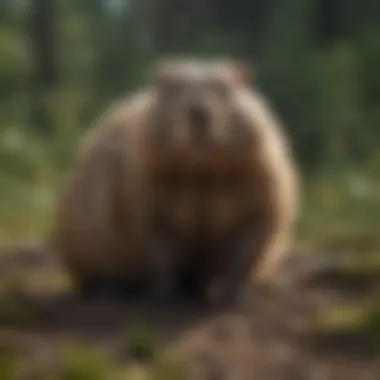
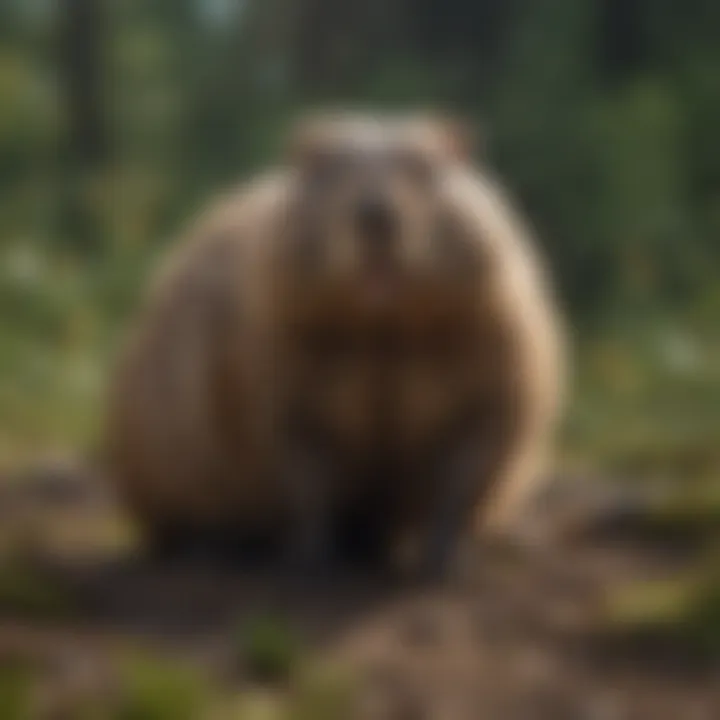
To begin, recognizing active groundhog trails is essential. These trails often feature signs such as flattened grass, droppings, or visible burrow entrances. Observe areas where plants show signs of being feasted upon. Groundhogs typically follow consistent paths as they venture out to forage. You may want to conduct this observation during early morning or late afternoon when they are most active.
Once you have identified these trails, you can position your bait nearby to improve your chances of success. Place bait at intervals along the trails to create a continuous lure. This method helps groundhogs feel confident in approaching the bait, thus increasing your capture rate.
Strategic Baiting Locations
The location of bait is another vital factor. Prioritize placement in areas shaded or sheltered by vegetation. Groundhogs prefer environments that provide some cover, as they are naturally cautious creatures. An area near their burrow often serves as an ideal spot, reinforcing their habitual paths.
Consider these points when choosing bait locations:
- Proximity to Food Sources: Place bait near areas rich in natural food sources. This creates competition and increases the likelihood that a groundhog will opt for your bait instead of its natural diet.
- Distance from Structures: Keep bait away from places where non-target species might find it easily, such as children's play areas or other domestic surroundings.
By following these best practices in bait placement, you increase the effectiveness of your groundhog management strategy, ensuring targeted results while minimizing unwanted consequences.
Cautionary Measures When Baiting
Baiting groundhogs can be an effective method for managing their populations, but it is essential to approach this task with caution. Understanding the implications of your baiting strategies not only contributes to more successful outcomes but also ensures that you are being responsible in your methods. Care must be taken to minimize unintended consequences that may arise from baiting practices. This section outlines critical factors to consider while baiting groundhogs, including concerns about non-target species and the overall impact on local ecosystems.
Avoiding Non-Target Species
One of the most significant concerns when baiting groundhogs is the risk of attracting non-target species. Various animals, such as squirrels, raccoons, and even domestic pets, might find and consume the bait intended for groundhogs. This situation can lead to unintended harm to these animals and potentially create new problems for you as a homeowner.
To avoid unnecessary interactions with non-target species, consider the following strategies:
- Choose Appropriate Bait: Select baits that are particularly attractive to groundhogs and less appealing to other wildlife. For instance, certain fruits like cantaloupe may be more enticing for groundhogs than for squirrels.
- Bait Placement: Position the bait in locations that are less accessible to non-target species. For example, placing bait further from pet areas or using traps designed specifically for groundhogs can help limit access to other animals.
- Monitor Bait Locations: Regularly check bait sites to see which animals are visiting. If you notice a pattern of non-target species, reassess your baiting strategy.
By being mindful of these factors, you can reduce the risk to other creatures while focusing on your primary objective of managing groundhogs.
Impact on Local Ecosystem
The act of baiting groundhogs has implications that extend beyond merely controlling their population. Groundhogs play a specific role in their ecosystems, and any changes to their numbers can affect the balance of local wildlife. Therefore, understanding the broader environmental impact is crucial.
Here are some aspects to contemplate:
- Food Chain Dynamics: Groundhogs serve as prey for various predators, including foxes and hawks. Removing or reducing their population can lead to food scarcity for these predators, causing them to seek alternative food sources. This shift can disrupt the natural food chain in the area.
- Soil Health and Plant Growth: Groundhogs contribute to soil aeration through their burrowing behaviors. A sudden decline in their numbers might affect soil quality in the long term. They also consume certain plants, and changes in their presence might lead to overpopulation of other species that they typically feed on.
- Biodiversity Considerations: Any management strategy should consider the local biodiversity. Excessive baiting could inadvertently affect other animal populations, potentially leading to imbalances in the ecosystem.
A balanced approach is vital. Understanding the full scope of your actions will help maintain a healthy environment.
Ethical Considerations in Baiting
Baiting groundhogs raises important ethical issues that need attention. It is crucial to balance the need for pest management with humane treatment of wildlife. The use of bait must consider the welfare of groundhogs and the larger ecological system. Understanding these ethical considerations can help one make informed decisions while managing groundhog populations effectively.
One major aspect of ethical baiting is minimizing pain and distress to the animals. Baiting should not lead to unnecessary suffering. Offering humane management practices can provide a path to coexistence with wildlife. This method respects the life of the groundhog while addressing the practical concerns of homeowners and gardeners.
Similarly, groundhogs are often part of a wider ecosystem. Their removal should not upset the balance of local wildlife. Therefore, when employing bait, understanding the overall impact on the ecosystem is essential. This consideration prevents unintentional consequences that might arise from baiting.
Furthermore, using non-toxic and organic baits is practical. It reduces the risk to other animals and the environment. Homeowners can be responsible for their local ecological well-being, gradually promoting healthier interactions with wildlife.
Humane Management Practices
Humane management practices in baiting involve using methods that focus on the well-being of groundhogs. Traps used for capturing groundhogs should adhere to humane standards. Live traps are a widely accepted form of capturing these animals without causing injury. The use of these traps ensures that the groundhogs can be removed safely without suffering.
When capturing groundhogs, it is essential to check traps frequently. Leaving an animal in a trap for extended periods can be distressing as they can suffer from dehydration or stress. Releasing them far from human habitation can support humane practices, allowing them to find new habitats.
Baiting strategies can also include utilizing natural deterrents. This can reduce reliance on traps and bait altogether. Examples include planting species that groundhogs find unpalatable, which encourages them to seek food elsewhere without harm.
Legal Aspects of Groundhog Control
Legal considerations play an important role in groundhog control. Each state has its specific regulations concerning wildlife management and pest control. Therefore, it is advisable to consult local wildlife laws before implementing baiting practices.
Some regions classify groundhogs as a non-game species. In these areas, homeowners may have more flexibility in how they manage them. However, capturing and relocating groundhogs may require permits. Failing to adhere to local laws can lead to penalties, making it essential to be informed.
Additionally, certain baiting methods may be restricted by law. For example, using poisonous substances for baiting is illegal in many areas due to safety concerns. Understanding and respecting these laws contributes to an ethical approach in managing groundhog populations.
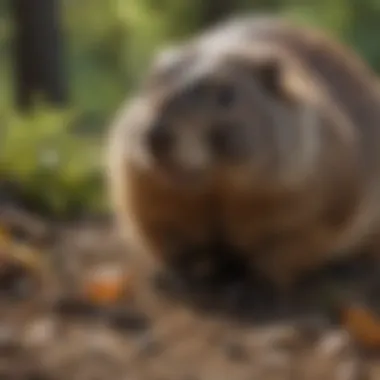

"Knowledge of legal aspects ensures that pest management is conducted within acceptable boundaries, promoting both animal welfare and personal responsibility."
In summary, ethical considerations in baiting groundhogs are vital for effective and humane pest management. Employing humane practices and being aware of legal aspects helps in maintaining a respectful relationship with wildlife while addressing the needs of homeowners.
Monitoring Success
Monitoring success is an integral part of managing groundhogs through baiting. Without proper evaluation of strategies, it is difficult to assess what is effective or what needs improvement. This section aims to elucidate why tracking groundhog activity and adjusting tactics based on observations are paramount.
Tracking Groundhog Activity
Understanding groundhog behavior is essential to successful management. Regular monitoring of their activity allows homeowners to determine when and where these creatures are most active. Observations can involve noting entry and exit points, the time of day they visit, and their dietary preferences at given times.
To track groundhog activity effectively, consider the following:
- Install Cameras: Camera traps can provide invaluable information on groundhog movement patterns. This helps to identify peak activity times.
- Look for Signs: Footprints, droppings, and chewed vegetation are clear indicators of groundhog presence. Regular inspection of these signs can reveal changes in their habits.
- Create a Log: Keeping a detailed record of sightings and behaviors can highlight trends over time, making it easier to predict future activity.
This tracking will empower homeowners with the knowledge needed to make informed decisions about bait placement and timing.
Adjusting Tactics Based on Observations
Adapting strategies in response to observations is crucial for maintaining effectiveness. Groundhogs are notoriously adaptive creatures, so rigid methods are often ineffective in the long term. Here are some approaches to consider:
- Identify Peak Feeding Times: If your observation indicates that groundhogs primarily feed at dusk, adjusting bait placement to earlier in the day could improve chances of catch.
- Rotate Baits: If certain baits are not attracting groundhogs, experiment with various options. For instance, if fruits are ignored, trying vegetables may yield better results.
- Modify Bait Locations: If certain trails become inactive, consider relocating the bait to areas where activity is noted. Understanding the terrain and groundhog routes is key.
By adapting your tactics, not only can you improve the chances of successful baiting, but also reduce the time and resources spent on ineffective methods. Constant monitoring allows homeowners to stay one step ahead of groundhog behavior, ensuring that strategies remain relevant and effective.
"Monitoring is not just about recording numbers but understanding patterns of animal behavior."
Alternative Groundhog Management Strategies
Managing groundhogs effectively requires a broad view of possible approaches. While baiting is a prominent method, looking at alternative strategies can enhance success rates and reduce potential frustrations. Alternative management methods serve crucial roles in pest control. They allow homeowners to adapt tactics based on specific circumstances and environmental factors. Furthermore, these strategies may minimize dependency on baits, creating a more balanced approach to wildlife management.
Exclusion Methods
Exclusion involves making areas less accessible to groundhogs. By reducing their entry points, you can protect gardens and lawns from damage. One effective exclusion method is to install fencing. A fence should be sturdy, ideally made of tall, wire mesh, and embedded at least a foot underground to prevent burrowing.
Consider these tips for effective fencing:
- Height: The fence should be at least three feet tall.
- Incline: Add a 45-degree angle at the top to discourage climbing.
- Material: Select durable materials to withstand wear from weather and animals.
Another exclusion strategy is securing potential den sites. Groundhogs often seek shelter in unwanted places like debris piles, sheds, or under decks. Regular cleaning and maintenance can minimize these habitats. Sealing gaps under decks or using gravel to fill holes can deter groundhogs as well. Keeping your property tidy makes it less appealing to them.
Repellents and Deterrents
Repellents can be useful to make gardens less inviting for groundhogs. Various commercial and homemade solutions exist. Sprays made from strong-smelling ingredients often work. For example, mixtures containing hot peppers and garlic can be effective. Applying these products regularly can create a barrier that discourages groundhogs from approaching.
Additionally, sensory deterrents, such as noise and movement, are practical. Wind chimes or motion-activated devices can help scare groundhogs away. This strategy relies on startling them, leading to a degree of temporary deterrence.
It is important to note that repellents may not offer a long-term solution. Groundhogs can habituate to certain smells or sounds. To keep effectiveness, rotate different types of repellents. This variation can improve the chances of success.
A combined approach using exclusion, repellents, and adequate management techniques can lead to a more sustainable solution for controlling groundhog populations.
In sum, exploring alternative management strategies broadens the understanding of groundhog dynamics. Through exclusion methods and the use of repellents, homeowners can address groundhog issues in a comprehensive manner. By integrating these methods with baiting practices, it becomes easier to protect gardens and landscapes while respecting local wildlife.
End
Baiting groundhogs effectively is crucial for managing their populations and minimizing damage to gardens and properties. By understanding groundhog behavior and dietary habits, homeowners can make informed decisions regarding bait selection and strategy implementation. This article emphasizes how appropriate bait, combined with strategic placement and ongoing monitoring, can lead to greater success in achieving desired outcomes.
Key Takeaways on Baiting
- Know Your Target: Understanding the specific preferences of groundhogs is essential. They favor certain fruits and vegetables, which can be leveraged for successful baiting.
- Placement Matters: Location of the bait plays a pivotal role. Baits placed in active trails or near burrows tend to attract groundhogs more effectively.
- Respect the Ecosystem: Approach baiting with consideration for other wildlife. Employ methods that do not inadvertently harm non-target species while managing pest populations.
- Monitor and Adapt: Regular checking of bait stations can provide insights into groundhog activity. Adjusting bait types and locations based on observed preferences will enhance overall efficiency.
Looking Ahead: Future Strategies
The future of groundhog management lies in integrating more humane practices and refined techniques. Here are some potential strategies:
- Increase Awareness: Educating homeowners about the benefits of various control methods is vital.
- Sustainable Solutions: Developing environmentally friendly repellents or exclusion methods could reduce reliance on baiting.
- Community Involvement: Encouraging local discussion forums, such as on Reddit, could foster shared knowledge and support among homeowners facing similar issues.
- Research and Innovation: Continued research into animal behavior and management strategies can unveil new methods, driving effective solutions in pest management.
Integrating humane management practices ensures the balance between pest control and ecological responsibility.
By focusing on these aspects, householders will be more prepared to tackle groundhog challenges with confidence and care.



